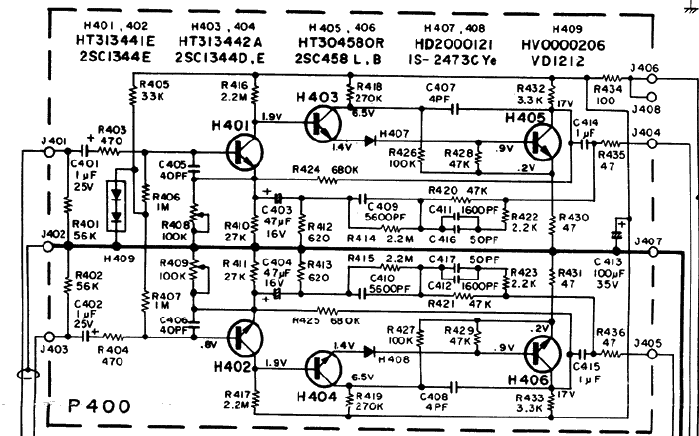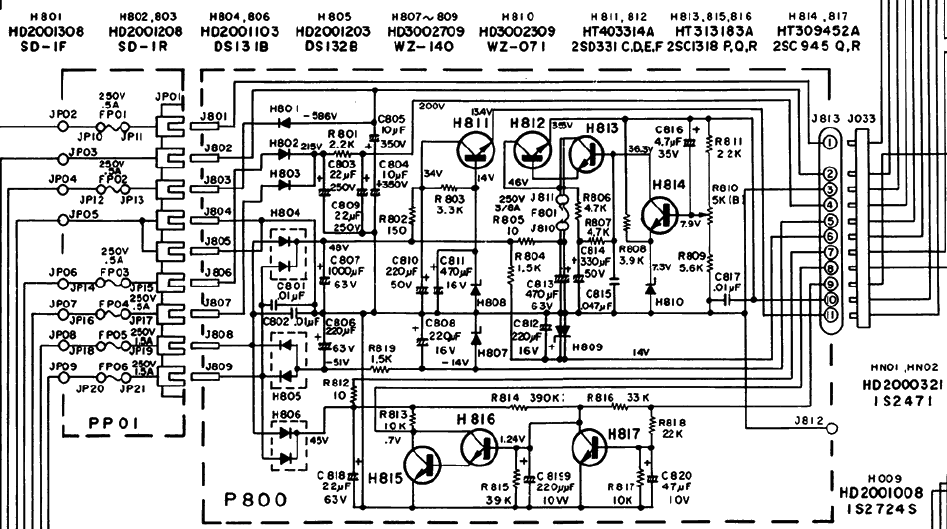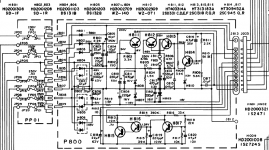I'm working on a receiver that has significant hiss in both channels when switched to phono. It's volume dependent and is there regardless of whether there's any signal being input. My question: Is it possible to "see" hiss on an oscilloscope? With more obvious distortion, I'd trace a 1kHz sine wave until I found the responsible component(s), but I'm wondering if hiss is visible in the same way.
There's always hiss, universal law. It's all relative.
Does it hiss with a turntable connected? Playing a record, is the vinyl noise higher than the hiss?
Does it hiss with a turntable connected? Playing a record, is the vinyl noise higher than the hiss?
Yes, you can see hiss on a 'scope - but only at the later points in the circuit where it has been amplified. It looks like grass (assuming an old-fashioned green trace 'scope). Most hiss comes from the early stages, where you might not see it.
If there is nothing connected to inputs they are floating, and with the gain of a phono pre who knows what noise will be induced.
HISS of some sort is inherent in phono preamps, it depends if the UUT meets its specification. If it is out of spec.
Short the phono inputs and see if the HISS reduces in volume. If not I would check the power supply first. But the list of suspects is long.
HISS of some sort is inherent in phono preamps, it depends if the UUT meets its specification. If it is out of spec.
Short the phono inputs and see if the HISS reduces in volume. If not I would check the power supply first. But the list of suspects is long.
The problem with seeing audio hiss on a 'scope is that the scope's input bandwidth is 100's of MHz, so it sees way more noise than what is present in the audio band - if your scope has bandwidth filtering you can use this to restrict to just the audio hiss.
Noise amplitude is proportional to the square-root of bandwidth, assuming white noise.
50nV/sqrt(Hz) noise over 20kHz is 7µV rms, over 100MHz is 0.5mV
Audio amplifier output noise spectrum is not going to be flat over 100MHz, so the 'scope without band limiting will not be useful for noise estimation.
Noise amplitude is proportional to the square-root of bandwidth, assuming white noise.
50nV/sqrt(Hz) noise over 20kHz is 7µV rms, over 100MHz is 0.5mV
Audio amplifier output noise spectrum is not going to be flat over 100MHz, so the 'scope without band limiting will not be useful for noise estimation.
I'm working on a receiver that has significant hiss in both channels when switched to phono.
Is there a tiny bit of chance this is the first time you are encountering a receiver with a phono stage and simply have no idea what to expect?
Thanks for all of the replies and suggestions.
@PRR - There's hiss with and without a turntable connected. The vinyl noise is higher than the hiss, though the hiss is still audible.
@warrjon - Shorting the inputs does reduce the volume of the hiss. I'm going to focus on the phono board.
@Mark Tillotson - My oscilloscope is a Tek 2336. I don't believe it has band limiting.
@analog_sa - It's a fair question, since you don't know me and shouldn't assume anything. But no, it isn't my first time hearing a receiver with a phono stage. I know dead quiet isn't going to happen even with some good outboard phono amps. But this is definitely more than what would be expected from even an average design.
@PRR - There's hiss with and without a turntable connected. The vinyl noise is higher than the hiss, though the hiss is still audible.
@warrjon - Shorting the inputs does reduce the volume of the hiss. I'm going to focus on the phono board.
@Mark Tillotson - My oscilloscope is a Tek 2336. I don't believe it has band limiting.
@analog_sa - It's a fair question, since you don't know me and shouldn't assume anything. But no, it isn't my first time hearing a receiver with a phono stage. I know dead quiet isn't going to happen even with some good outboard phono amps. But this is definitely more than what would be expected from even an average design.
Disclosing the particular model may be useful. I think MM phono inputs inside receivers have on average 20-30db more noise than high the level inputs. MC inputs are obviously a lot noisier.
It is probably better to forget the scope and measure the S/N ratio using a soundcard with inverse riaa, then repeat the measurement through a high level input and compare.
Dried out electrolytic caps in voltage regulators and local decoupling may have a strong effect on hiss.
It is probably better to forget the scope and measure the S/N ratio using a soundcard with inverse riaa, then repeat the measurement through a high level input and compare.
Dried out electrolytic caps in voltage regulators and local decoupling may have a strong effect on hiss.
How old a receiver?-- my Pioneer's use single +22V/-13V and there are electrolytic caps on the output of the phono stage -- just as Analog_SA mentions above. If the cap has gone leaky then power supply noise may be on the output. Is there any DC at the output of the phono stage?
fwiw, the Tek 2336 has a pretty sensitive front-end, but not sensitive enough for noise measurement, cost $4,300 when new!
fwiw, the Tek 2336 has a pretty sensitive front-end, but not sensitive enough for noise measurement, cost $4,300 when new!
Disclosing the particular model may be useful. I think MM phono inputs inside receivers have on average 20-30db more noise than high the level inputs. MC inputs are obviously a lot noisier.
It is probably better to forget the scope and measure the S/N ratio using a soundcard with inverse riaa, then repeat the measurement through a high level input and compare.
Dried out electrolytic caps in voltage regulators and local decoupling may have a strong effect on hiss.
It's a Marantz 4400. Good idea about measuring the S/N ratio with a soundcard. Thanks.
How old a receiver?-- my Pioneer's use single +22V/-13V and there are electrolytic caps on the output of the phono stage -- just as Analog_SA mentions above. If the cap has gone leaky then power supply noise may be on the output. Is there any DC at the output of the phono stage?
fwiw, the Tek 2336 has a pretty sensitive front-end, but not sensitive enough for noise measurement, cost $4,300 when new!
I hadn't, but I will check for DC at the output of the phono stage.
Yep, I like my little (relatively) 2336. Talk about depreciation. I think it ran me $100 used.
If you join "hifi engine" you can get a free copy of the schematic and service manual.
Marantz 4400 - Manual - Stereo and Quadradial AM/FM Receiver - HiFi Engine
PC Board P400 is the phono board. If you disconnect the wires connected to J404 and J405, (the output pins of the phono board -- probably wire-wrap) and ground these wires, you can determine whether the fault is in the phono board or in a connection from the phono board.
Sometimes these old transistors just fail.
Marantz 4400 - Manual - Stereo and Quadradial AM/FM Receiver - HiFi Engine
PC Board P400 is the phono board. If you disconnect the wires connected to J404 and J405, (the output pins of the phono board -- probably wire-wrap) and ground these wires, you can determine whether the fault is in the phono board or in a connection from the phono board.
Sometimes these old transistors just fail.
Its also the carbon film resistors in the phono stage, change them to 1% metal films while your’re changing the capacitors if your ambitious.
It's a Marantz 4400.
60db S/N from specs. Unacceptable from today's perspective even if original specs are still maintained.
Recapping + phono stage transistor replacement.
Like a lot of hi-fi gear at the time, these old Marantz receivers were were conservatively rated.
Here's the circuit:

And here's the power supply:

Critical caps: C713, C816 - replace with 50-63 V parts. C403/404 would have to basically go open to affect noise levels severely, but are worth a check.
Zener H810 could use something like 220 µF in parallel, at which point I would also reduce its current to make the filtering more effective by upping R808 to 10-15k (readjust output voltage afterwards).
Critical transistors: The two 2SC458s are arguably the most dodgy candidates, even though 2SC1344 and VD1212 are no unknowns when it comes to intermittency. Static bursts do not equal permanent hiss though.
If I have my math right, the input transistor is running at a measly 15 µA, possibly less - I've seen <100 µA, even 30 µA, but rarely something quite this low. Surprisingly, this should still yield voltage noise low enough (well below 10 nV/sqrt(Hz)), though it makes input capacitance rather critical (having Vbe of only ~1.7 V does not help) and obviously is rather demanding in terms of transistor leakage. With good parts this circuit should not be unduly noisy at all.
Obviously I would prefer the more common kind of 3-transistor circuit that puts the buffer at the output rather than in the middle (see e.g. Kenwood KA-6004). That said, this circuit here seems to have been used in quite a range of vintage Marantz receivers for several years. Can't have been that bad.
Here's the circuit:
And here's the power supply:
Critical caps: C713, C816 - replace with 50-63 V parts. C403/404 would have to basically go open to affect noise levels severely, but are worth a check.
Zener H810 could use something like 220 µF in parallel, at which point I would also reduce its current to make the filtering more effective by upping R808 to 10-15k (readjust output voltage afterwards).
Critical transistors: The two 2SC458s are arguably the most dodgy candidates, even though 2SC1344 and VD1212 are no unknowns when it comes to intermittency. Static bursts do not equal permanent hiss though.
If I have my math right, the input transistor is running at a measly 15 µA, possibly less - I've seen <100 µA, even 30 µA, but rarely something quite this low. Surprisingly, this should still yield voltage noise low enough (well below 10 nV/sqrt(Hz)), though it makes input capacitance rather critical (having Vbe of only ~1.7 V does not help) and obviously is rather demanding in terms of transistor leakage. With good parts this circuit should not be unduly noisy at all.
Obviously I would prefer the more common kind of 3-transistor circuit that puts the buffer at the output rather than in the middle (see e.g. Kenwood KA-6004). That said, this circuit here seems to have been used in quite a range of vintage Marantz receivers for several years. Can't have been that bad.
Attachments
60db S/N from specs. Unacceptable from today's perspective even if original specs are still maintained.
Recapping + phono stage transistor replacement.
I believe that the 2SC1344 are ECB not EBC so it's a bit more difficult than a swap. Noise figure for these quoted a 1dB
If you are keeping the 4400 for "numismatic value" -- I wouldn't touch the phono board -- just build yourself a Doug Self RIAA pre and run it on the AUX channel.
What's the quality of the hiss? If it's smooth it's likely the design. If it's rough with some irregular pops, it might be noisy transistors.
Carbon film resistors are already very quiet and changing those probably won't accomplish anything. Carbon composition, maybe, but I don't know what's in there. Changing low value resistors won't change anything. Values above 50 kohms might.
I'm put my efforts into the power supply quality and make sure the transistors are OK. Note that simple RIAA circuits tend to be affected by transistor gain, so I don't like to change parts for the sake of changing parts.
Carbon film resistors are already very quiet and changing those probably won't accomplish anything. Carbon composition, maybe, but I don't know what's in there. Changing low value resistors won't change anything. Values above 50 kohms might.
I'm put my efforts into the power supply quality and make sure the transistors are OK. Note that simple RIAA circuits tend to be affected by transistor gain, so I don't like to change parts for the sake of changing parts.
I just spent some time trying to isolate the origin of the hiss (relatively smooth, Conrad) using a signal tracer on the phono board. First, I need to correct myself: I said it was the same in both channels, but it's actually noticeably louder in the right. And based on what I could hear with the signal tracer, tt seems to arise at the junction of R421, R423, and R426. Unfortunately, since using the tracer I have significant hum that's overpowering the hiss when monitor the output over headphones.
I just finished telling someone this morning that I don't like to shotgun repairs, but in this case, I'm leaning toward just replacing the electrolytics and notorious transistors in both the phono board and power supply.
I just finished telling someone this morning that I don't like to shotgun repairs, but in this case, I'm leaning toward just replacing the electrolytics and notorious transistors in both the phono board and power supply.
If I have my math right, the input transistor is running at a measly 15 µA, possibly less - I've seen <100 µA, even 30 µA, but rarely something quite this low. Surprisingly, this should still yield voltage noise low enough (well below 10 nV/sqrt(Hz)), though it makes input capacitance rather critical (having Vbe of only ~1.7 V does not help) and obviously is rather demanding in terms of transistor leakage. With good parts this circuit should not be unduly noisy at all.
Obviously I would prefer the more common kind of 3-transistor circuit that puts the buffer at the output rather than in the middle (see e.g. Kenwood KA-6004). That said, this circuit here seems to have been used in quite a range of vintage Marantz receivers for several years. Can't have been that bad.
The noise minimum is about IC ~= (kT/q) * sqrt(hFE)/Zs. With Zs about 12 kohm (effective RIAA- and A-weighted average impedance of a 500 mH cartridge) and hFE around 250, IC ~= 33.3 uA. It's a rather flat optimum, so anything from 15 uA to 70 uA should be close enough.
When the input electrolytic AC coupling capacitors are dried up and have much reduced capacitance, you will probably hardly notice this except by the increased impact of the amplifier's input noise current. The noise should then sound like a very low rumble rather than hiss, though.
- Home
- Source & Line
- Analogue Source
- Pinpointing the source of hiss in a phono stage

